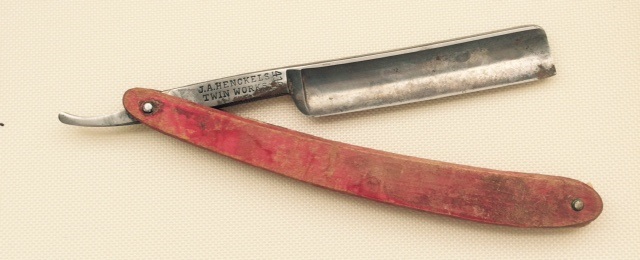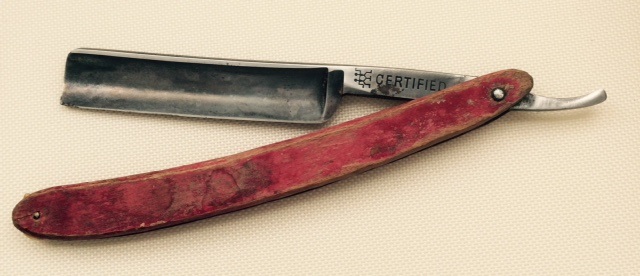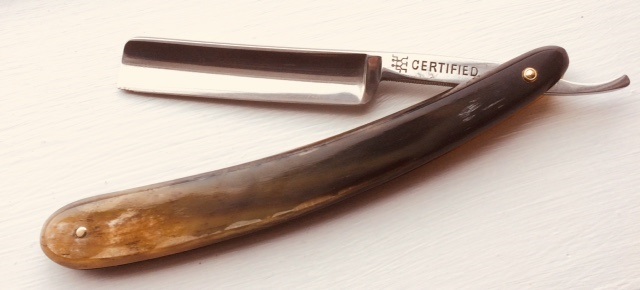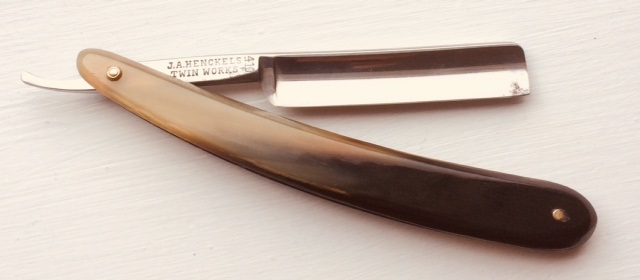Results 1 to 10 of 19
-
09-03-2017, 02:35 PM #1
 JA Henckels Restore -- Need Advice
JA Henckels Restore -- Need Advice
I am going to restore this JA Henckels SR. The scales are wood.
Scales are loose, but could be tightened easily. There is a tiny crack on one scale at one end. I feel the scales are salvageable. The blade is in good shape...a bit of hone wear but in good shape otherwise.
My questions are: Do I sand the scales and paint red as the original? (I don't know if these were the original scales or if they were replaced at some time in the past). Do I sand the scales and just use some type of wood oil to bring out the qualities of the wood and grain? Or do I scrap the scales and put on new scales. (I have new horn scales that would fit nicely.) Any thoughts or ideas would be welcomed.


-
09-03-2017, 02:55 PM #2Senior Member



- Join Date
- Mar 2012
- Location
- Thunder Bay, Ontario, Canada
- Posts
- 17,377
Thanked: 3228
I have my doubts that Henckels ever used painted wooden scales at the factory. I would chuck those and use your horn scales.
BobLife is a terminal illness in the end
-
09-03-2017, 05:48 PM #3

Can't hurt to remove them, give a bit of sanding time to one side of a scale and see what's there.
Never know whatcha got.
-
09-03-2017, 06:44 PM #4

I think id go with the horn. But before anything, I'd put the blade on a 1K stone and see about that rust on the tip. Hate to waste time working on it if the steal is rusted too much to save that tip. If tip is not savable it would work well for a cut down of just the tip or regrind the tip to a round point. Its got some hone ware but the bevel looks straight so it might hone up to a nice bevel still. JMHO. Good luck.
It's just Sharpening, right?
Jerry...
-
09-03-2017, 07:17 PM #5

Someone has made replacement scales for it, though they look like perfect replica's, by shape.
I just made a set for Sharptons #14, not too long ago.
Un pin it, Sand the paint away, and see if the grain looks nice.
If its cool looking, put a oil finish to them. I like TruOil, from Birchwood& Casey.Mike
-
09-03-2017, 07:37 PM #6

Myself I would un-pin them and give them a sanding to see what the grain pattern looks like. There could be something nice lurking under the paint. What could it hurt since you do already have a set of horn scales too. One set could be used on another razor.
-
09-04-2017, 02:01 PM #7

Great advice as usual! Thank you. I will start working on this over today and maybe this week...depending on household demands. I am going to remove the scales and clean up the blade and apply new horn scales. I will keep the wood scales and maybe use them either as a template for home-made scales or for practice. I will post my progress.
-
09-04-2017, 06:09 PM #8

Update: Spent some time this afternoon cleaning up the blade. The rust at the tip was not significant, but some pitting of the edge was present at the extreme end. I decided to leave it be and not round the tip. I will see how it hones before I do anything drastic. Shined up nice. Next step: new horn scales.


Last edited by Whizbang; 09-04-2017 at 06:11 PM.
-
09-04-2017, 06:39 PM #9

Nice job on the cleanup. I'd have left the pitting too. Looks like you got a winner.
It's just Sharpening, right?
Jerry...
-
10-29-2017, 03:42 PM #10

It took me a while, but I finally got around to putting on a new set of horn scales on this 410 J.A. Henckels Twin Works blade. This is only my second re-scaling project. I am quite pleased.


-
The Following User Says Thank You to Whizbang For This Useful Post:
Geezer (11-13-2017)


 58Likes
58Likes LinkBack URL
LinkBack URL About LinkBacks
About LinkBacks






 Reply With Quote
Reply With Quote
